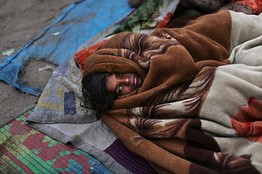In Pic :A homeless girl slept on the ground on a cold morning in New Delhi in January.
My reaction to watching “Les Misérables” on stage in London in late 1985 was very different from my reaction when I saw it at the cinema in Delhi last week.
In 1985 London, I was enthralled and moved by the spectacle. In 2013 Delhi, I was like, whatever.
It’s true that the original stage version had the spine-tingling voices of Colm Wilkinson and Roger Allam and now we have to make do with the brave attempts of Hugh Jackman and Russell Crowe -– but I think it’s more than that. I think the intervening years I’ve spent in urban India have hardened me. I see so much poverty on the streets of India’s mega-cities on a daily basis that what I saw on the screen left me largely unmoved.
When I heard beautiful little Cossette sing “Castle on a Cloud” in 1985 London, I cried through the entire song. How could people treat a child this way? In 2013 Delhi, I merely raised a graying eyebrow and waited politely for the song to be finished. Child labor is not rare here in India, with girls and boys of Cossette’s age doing everything from delivery, manning vegetable stalls, and cooking, to working long hours in factories. They, too, are looking for a place where there aren’t any floors for them to sweep, but it’s not here. Here you may well see Cossette selling trinkets at any one of the busy traffic intersections or begging with a baby brother on her hips.
In 1985, I was amused to hear spunky little Gavroche sing “Be careful as you go, ‘cos little people grow.” Now I know that some do, and some unfortunately don’t.
“At the end of the day, you’re another day older”? Only if you’re lucky. India leads the world in the number of deaths of children under 5 years of age.
And had Gavroche been living in Delhi in 2013, instead of the robust cherubic boy we saw on stage and screen, he would more likely have been scrawny. Some 43% of children under the age of 5 are malnourished, and I imagine those over 5 are not doing so well either. As Gavroche says, they “live on crumbs of humble piety. Tough on the teeth, but what the hell.”
When in 1985 London, I heard Fantine sing “I Dreamed a Dream,” I shivered. Okay, so it was December in London, but in the cheap seats in the top rows of the Palace Theatre it was more than warm. This poor young woman, unprotected and on the streets, and what with the tigers coming at night. Now, though, I just think that’s the life of the unfortunate – like the families, with infants and grandparents, sleeping nightly under Delhi’s overpasses or the even less fortunate ones, sleeping on the open pavements, throughout the year. Yep, they too “dreamed that God would be forgiving.” But what to do?
At least Fantine survived childbirth. In India, 70% of pregnant women are anemic and there is a maternal death every 10 minutes, amounting to some 56,000 deaths a year. “There are dreams that cannot be.”
In London, I was on the edge of my seat as the mighty Valjean carried Marius through the sewers. Well, here in Delhi you don’t have to go underground to see sewage; the sewage can come to you. To get out of my neighbourhood, I have to daily drive through a street where the sewage is overflowing. But at least I’m in a car. Many children have to walk down the same street to get to and from school. They navigate with their pants rolled up and bags held high. They cling to the boundary walls to avoid the muck as much as possible. Last week, I saw one older boy carrying a younger one on his back and trudging through the sewage … much as Valjean carried Marius. “Bring him home. Bring him home.”
“Look down and see the beggars at your feet.” One day I took a different route home. Waiting at a traffic light, I heard a tapping on my car door. First, I didn’t see anyone. Then, when I looked down, I saw an old man sitting on a plank of wood with wheels. He had no legs. He was a nobody. And he was a mainstay of that intersection for years. “Look down, look down, upon your fellow man.”
With time and repeated exposure, one becomes immune. And this from a person who has a reputation as a prime sap. There used to be a time when, during sad parts of movies, my husband and daughter would turn and watch me for entertainment because I was sure to provide blubbering waterworks. But that was then; this is now. If I see numerous such sights on a daily basis and simply have to plough through and get on with the task of living, what is to make me cry when I see the same thing on the screen? Background music?
If you want me to cry for you, Anne Hathaway, take a number.
–Ranjani Iyer Mohanty is a writer, academic editor, and erstwhile prime sap, living in Delhi.






Leave a reply